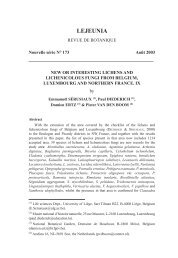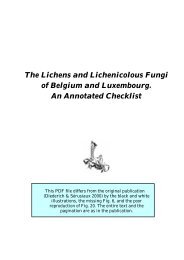A Synopsis of the Genera Skyttea, Llimoniella and - Lichens of ...
A Synopsis of the Genera Skyttea, Llimoniella and - Lichens of ...
A Synopsis of the Genera Skyttea, Llimoniella and - Lichens of ...
Create successful ePaper yourself
Turn your PDF publications into a flip-book with our unique Google optimized e-Paper software.
470 THE LICHENOLOGIST Vol. 32<br />
<strong>the</strong> species is similar to R. neglectus, which usually has shorter ascospores (see<br />
identification key).<br />
Lecidea pertusariicola Jatta, described from Italy on Pertusaria pertusa, might<br />
represent an older name for this species. However, <strong>the</strong> original description is<br />
absolutely insufficient (Vouaux 1912-14), <strong>and</strong> <strong>the</strong> type specimen has never<br />
been re-examined.<br />
Additional specimen examined. Russia: Taymir Peninsula, region <strong>of</strong> Lewinson-Lessing Lake,<br />
vii 1994, Zhurbenko 9462 (LE).<br />
Rhymbocarpus pubescens (Etayo & Diederich) Diederich & Etayo<br />
comb. nov.<br />
<strong>Llimoniella</strong> pubescens Etayo & Diederich, Lichenologist 30: 108 (1998); type: Spain, Navarra,<br />
alto de Lizarraga, 900 m, on Fagus, on Lepraria lobificans, iv 1992, Etayo 3052 (MA-Lichen—<br />
holotypus; LG, hb. Diederich, hb. Etayo—isorypi).<br />
For a description <strong>and</strong> illustrations, see Etayo & Diederich (1998).<br />
Hosts. Etayo & Diederich (1998) studied several specimens on Lepraria sp.,<br />
including L. lobificans.<br />
Distribution. Great Britain (Scotl<strong>and</strong>), Spain (Pyrenees) <strong>and</strong> Papua New<br />
Guinea (Etayo & Diederich 1998).<br />
Rhymbocarpus stereocaulorum (Alstrup & D. Hawksw.) Etayo &<br />
Diederich comb. nov.<br />
Geltingia stereocaulorum Alstrup & D. Hawksw., Meddr Grenl<strong>and</strong>, Biosci. 31: 34 (1990).—<br />
<strong>Llimoniella</strong> stereocaulorum (Alstrup & D. Hawksw.) Hafellner, in Zhurbenko & Santesson, Herzogia<br />
12: 155 (1996); type: Greenl<strong>and</strong>, Godthab (Nuuk), on Stereocaulon, vii 1946, Christiansen 5547<br />
(C—holotypus, vid.).<br />
(Fig. 7C)<br />
For a description <strong>and</strong> additional illustrations, see Alstrup & Hawksworth<br />
(1990).<br />
Hosts. Stereocaulon species, including S. rivulorum.<br />
Distribution. Greenl<strong>and</strong>, Norway <strong>and</strong> Russia.<br />
Observations. The hymenium is olivaceous green, K+ olivaceous (to brownish),<br />
<strong>and</strong> die exciple olivaceous green when young <strong>and</strong> brownish when old.<br />
When young, <strong>the</strong> outer exciple consists <strong>of</strong> elongate, terminal cells, embedded<br />
in gel (similar to hairs) (see Fig. 7C). The ascospores are <strong>of</strong>ten larger than<br />
indicated in <strong>the</strong> original account, reaching 20 (im in length.<br />
Additional specimens examined. Norway: Oppl<strong>and</strong>, Vaga par., Abakken, N <strong>of</strong> Lake Vagavatn, on<br />
5. rivulorum, 1961, Santesson 14241 (UPS, hb. Diederich).—Russia: NW Siberia: T'umenskaia<br />
oblast', Gvdan Peninsula, Chuhor'-Yakha River, 69°7'N, 74°40'E, on Stereocaulon, vii 1991,<br />
Andreev (UPS [dupl. from LE]).





